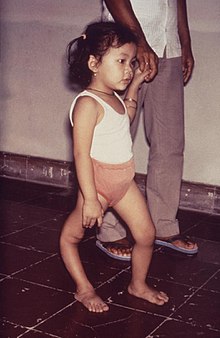Medical condition
| Genu recurvatum | |
|---|---|
 | |
| Ella Harper, a sideshow performer, had genu recurvatum and was billed as "The Camel Girl." | |
| Specialty | Medical genetics, rheumatology |
Genu recurvatum is a deformity in the knee joint, so that the knee bends backwards. In this deformity, excessive extension occurs in the tibiofemoral joint. Genu recurvatum is also called knee hyperextension and back knee. This deformity is more common in women and people with familial ligamentous laxity. Hyperextension of the knee may be mild, moderate or severe.
The normal range of motion (ROM) of the knee joint is from 0 to 135 degrees in an adult. Full knee extension should be no more than 10 degrees. In genu recurvatum, normal extension is increased. The development of genu recurvatum may lead to knee pain and knee osteoarthritis.
Causes

The following factors may be involved in causing this deformity:
- Inherent laxity of the knee ligaments
- Weakness of biceps femoris muscle
- Instability of the knee joint due to ligaments and joint capsule injuries
- Inappropriate alignment of the tibia and femur
- Malunion of the bones around the knee
- Weakness in the hip extensor muscles
- Gastrocnemius muscle weakness (in standing position)
- Upper motor neuron lesion (for example, hemiplegia as the result of a cerebrovascular accident)
- Lower motor neuron lesion (for example, in post-polio syndrome)
- Deficit in joint proprioception
- Lower limb length discrepancy
- Congenital genu recurvatum
- Cerebral palsy
- Muscular dystrophy
- Limited dorsiflexion (plantar flexion contracture)
- Popliteus muscle weakness
- Connective tissue disorders. In these disorders, there are excessive joint mobility (joint hypermobility) problems. These disorders include:
Pathophysiology
The most important factors of knee stability include:
- Ligaments of the knee: The knee joint is stabilized by four main ligaments:
- Anterior cruciate ligament (ACL). The ACL has an important role in stabilization of knee extension movement by preventing the knee from hyperextending.
- Posterior cruciate ligament (PCL)
- Medial collateral ligament (MCL)
- Lateral collateral ligament (LCL)
- Joint capsule or articular capsule (especially posterior knee capsule)
- Quadriceps femoris muscle
- Appropriate alignment of the femur and tibia (especially in knee extension position )
Treatment
Treatment generally includes the following:
- Sometimes pharmacologic therapy for initial disease treatment
- Physical therapy: physiotherapy will be beneficial in patient with complaint of pain, discomfort.
- Occupational therapy
- Use of appropriate assistive devices such as orthoses
- Surgery
Incidence
This condition is considered to be rare, with about 1 in 100,000 births being affected by the congenital form of genu recurvatum, although it's a common feature in some disorders, such as in joint hypermobility, which affects 1 in 30 people.
See also
References
- Pednaud, J. Tithonu (8 May 2006). "The Human Marvels". thehumanmarvels.com. Retrieved 24 April 2010.
- Benson, Michael; Fixsen, John; Macnicol, Malcolm (1 August 2009). Children's Orthopaedics and Fractures. Springer. p. 495. ISBN 978-1-84882-610-6.
- "Congenital Genu Recurvatum". Medical Bag. 7 February 2013. Archived from the original on 5 November 2021. Retrieved 5 November 2021.
- "Ehlers-Danlos syndromes". nhs.uk. 18 October 2017.
External links
- The American Academy of Orthotists and Prosthetists
- The differential diagnosis of children with joint hypermobility: a review of the literature
- The American Academy of Orthotists and Prosthetists
| Classification | D |
|---|
| Acquired musculoskeletal deformities | |||||||||
|---|---|---|---|---|---|---|---|---|---|
| Upper limb |
| ||||||||
| Lower limb |
| ||||||||
| Head and neck | |||||||||
| General terms | |||||||||
| Congenital malformations and deformations of musculoskeletal system / musculoskeletal abnormality | |||||||||||||||||||||||
|---|---|---|---|---|---|---|---|---|---|---|---|---|---|---|---|---|---|---|---|---|---|---|---|
| Appendicular limb / dysmelia |
| ||||||||||||||||||||||
| Axial |
| ||||||||||||||||||||||